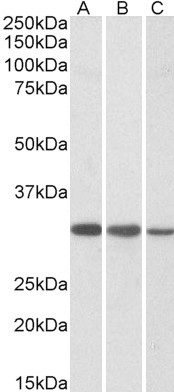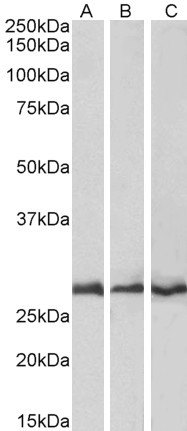Formulation Supplied at 0.5 mg/ml in Tris saline, 0.02% sodium azide, pH7.3 with 0.5% bovine serum albumin.
| |
Unit Size 100 µg | |
Storage Instructions Aliquot and store at -20°C. Minimize freezing and thawing. | |
Synonym / Alias Names F-actin capping protein beta subunit|Cap Z|MGC129750|MGC129749|MGC104401|RP4-657E11.7|Cap Z|CAPPB|CAPZ|CAPB|capping protein (actin filament) muscle Z-line, beta|CAPZB | |
Accession ID NP_004921.1 | |
Blocking Peptide EBP05143 | |
Immunogen Peptide with sequence NDLVEALKRKQQC, from the C Terminus of the protein sequence according to NP_004921.1. | |
Product Comments This antibody is expected to be specific for the beta2 isoform of capping protein, found in non-muscle cells and should not recognise the beta1 form. | |
Peptide Sequence NDLVEALKRKQQC | |
Purification Method Purified from goat serum by ammonium sulphate precipitation followed by antigen affinity chromatography using the immunizing peptide. | |
Shipping Instructions Refrigerated | |
Predicted Species Human, Mouse, Rat, Dog, Pig, Cow | |
Reactive Species Human, Mouse, Rat, Pig | |
Human Gene ID 832 | |
Mouse Gene ID 12345 | |
Product Grade  | |
ELISA Detection Limit Antibody detection limit dilution 1:32000. | |
Western Blot Approx 30kDa band observed in lysates of cell lines Jurkat, HeLa and NIH-3T3 and approx 28kDa band observed in Mouse, Rat and Pig Heart lysates (calculated MW of 30.6kDa according to Human NP_004921.1 and 31.3kDa according to Mouse NP_001032850.1, and 30.6kDa according to Rat NP_001005903.1 and Pig NP_001106915.1]. Recommended concentration: 0.1-0.3µg/ml. Primary incubation was 1 hour. This product has been successfully used in WB on Rat: Wang CY et al, J Biomed Sci. 2011 Feb 7;18:13. PMID: 21299884. | |
Application Type Pep-ELISA, WB |
Goat Anti-CAPZB Antibody
$423.00
| SKU | Unit Size | Price |
|---|---|---|
Select a unit size:
Selected References [{"pmid": 21299884, "intro": "This antibody has been successfully used in Western blot on Rat:", "title": "Reduction in antioxidant enzyme expression and sustained inflammation enhance tissue damage in the subacute phase of spinal cord contusive injury.", "author": "Wang CY, Chen JK, Wu YT, Tsai MJ, Shyue SK, Yang CS, Tzeng SF.", "journal": "J Biomed Sci. 2011 Feb 7;18:13."}] |


